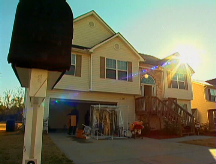Housing relief efforts slow as pace of foreclosures rise
Hope Now reports that it has helped keep over a half a million home owners out of foreclosure this year. Critics say that still isn't enough.
| 30 yr fixed | 3.80% |
| 15 yr fixed | 3.20% |
| 5/1 ARM | 3.84% |
| 30 yr refi | 3.82% |
| 15 yr refi | 3.20% |
NEW YORK (CNNMoney.com) -- The pace of housing rescue efforts slowed in the first quarter of the year, according to a new report, while the number of people losing their homes to foreclosure skyrocketed during the same period.
More than a half million at-risk home owners had their loans reworked during the first three months of the year, according to Hope Now, the coalition of mortgage lenders, servicers, investors and community advocates put together to help ease the foreclosure crisis. Nearly 1.4 million homeowners have gone through some sort of loan workout since July.
But the effort is not keeping pace with the rate of foreclosures.
"Unless you think the foreclosure problem [is bottoming out], the deceleration in workouts might be considered a disappointment," said economist Jared Bernstein of the Economic Policy Institute. He doesn't think that the mortgage crisis has hit its nadir yet.
"All the signs indicate that we're still headed for the bottom," said Bernstein, who is the author of Crunch: Why Do I Feel so Squeezed?. "You definitely want to see these workouts ramping up at a higher rate."
The administration-backed coalition says that through the end of March it helped 503,000 homeowners avoid foreclosure. That's up just 6% from the roughly the 473,000 borrowers it helped in the last quarter of 2007 - and a notable slowdown from the 20% increase in the number of people Hope Now helped in 2007's third quarter.
Meanwhile, the number of homes lost to bank repossessions during the first three months of 2008 totaled 205,207, up 36% from 151,403 a quarter earlier, according to Hope Now.
"Hope Now is helping some people," said Bernstein, "but not enough to hasten the [housing] correction along. It's a small piece of the puzzle."
A report last week by the State Foreclosure Prevention Working Group concluded similarly that troubled borrowers aren't getting enough help. The coalition, formed last year by 11 state attorneys general and bank regulators, pointed out that although mortgage workouts had increased, the number of at-risk borrowers had risen just as quickly, if not faster. Its conclusion: seven out of 10 home owners who needed help were not getting it.
The good news is that a growing percentage of troubled borrowers are getting their mortgages modified, which makes mortgage payments more affordable by either reducing the loan's balance, lowering the interest rate or both. The rest get repayment plans, which add missed payments on to monthly bills, or tack them on to the end of the mortgage.
During the first quarter 36% of the borrowers who turned to Hope Now received mortgage modifications, up from 30% of borrowers who got modifications in the last quarter of 2007 and only 19% in the third quarter of last year.
"Hope Now is providing a way for homeowners to find real solutions so that they can stay in their homes," coalition director Faith Schwartz said in a prepared statement.
Bernstein conceded that Hope Now has helped a lot of people.
"It's great as far as it goes," he said. "It just doesn't go far enough." ![]()


